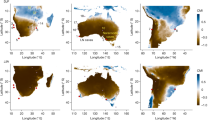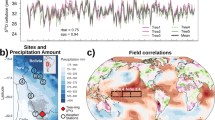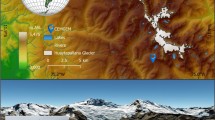Abstract
RECENT attempts to explain the glacial aridity at upper elevations in the Galapagos Islands have failed to take into account either concurrent events in neighbouring areas1–6 or modern causes of climate. Yet, any reconstruction of the glacial climatology of the South Pacific must be consistent with all these data. Recognised glacial features of the region that must be taken into consideration and the empirical evidence which supports them include: increased upwelling along the equatorial divergence (enhanced plankton production7, simultaneous build up of guano8), upper elevation (650 m) aridity relative to the present in the Galapagos Islands (dated palaeomicrofloras1); increased precipitation above 2,000 m along the western slopes of the Peruvian Andes (deposits of oxides9,10, traces of humid cycle stream cutting and scouring of alluvium9–11, remains of sheet flooding at the base of the mountains9,10 a disproportionate lowering of the west facing glacial snowline12, relics of formerly more continuous plant and animal distributions13,14); continuous aridity throughout the Pleistocene along the Peruvian coast (unbroken sequence of arid cycle processes9–11); and exposure of large areas of the western Indo–Australian region following the 100–120 m sea level drop16 (fossil terraces16,17). It can be deduced from the position of this exposed land that the modern pattern of vernal mixing of water from the eastern and western Pacific could not have taken place17 and that the eastern Pacific anticyclone did not, therefore, weaken in the glacial summer17. Thus, the pressure gradients between the two sides of the ocean would have remained fixed throughout the year and the eastern anticyclone and the south-east trade winds would have retained high intensity in both summer and winter.
This is a preview of subscription content, access via your institution
Access options
Subscribe to this journal
Receive 51 print issues and online access
$199.00 per year
only $3.90 per issue
Buy this article
- Purchase on SpringerLink
- Instant access to full article PDF
Prices may be subject to local taxes which are calculated during checkout
Similar content being viewed by others
References
Colinvaux, P. A., Nature, 240, 17–20 (1972).
Houvenaghel, G., Nature, 250, 565–566 (1974).
Newell, R. E., Nature, 245, 91–92 (1973).
Suzuki, H., Bull. Dept geog., Univ. Tokyo, 5, 3–32 (1973).
Damuth, J. E., and Fairbridge, R. W., Bull. geol. Soc. Am., 81, 89–206 (1970).
Fairbridge, R. W., Quat. Res., 2, 283–302 (1972).
Arrhenius, G. O. S., in The Atmosphere and the Sea in Motion (edit. by Bolen, B.), 121–129 (Rockefeller Inst. Press, 1959).
Hutchinson, G. E., Bull. Am. Mus. Nat. Hist., 96, 1–554 (1950).
Tricart, J., Arid Zone Research Series, UNESCO, 20, 45–419 (Belgium, 1963).
Tricart, J., Dollfus, O., Cloots-Hirsch, A. R., Étude francaise sur le Quaternaire, VIII. Congres. Int. INQUA. Supp. Bull. A.F.E.Q. for 1969, 215–234 (1969).
Garner, H. F., Bull. geol. Soc. Amer., 70, 1327–1368 (1959).
Hastenrath, S., S. African geog. J., 53, 53–69 (1971).
Vuilleumier, B. S., Science, 173, 771–780 (1971).
Paynter, R. A., jun., Bull. Mus. comp. Zool., 143, 297–320 (1972).
Köpcke, M., Bonn. Zool. Beitr., 2/4, 130–193 (1958).
Flint, R. F., Glacial and Quaternary Geology (Wiley and Sons, 1971).
Quinn, W. H., Nature, 229, 330–331 (1971).
Alpert, L., in Galapagos Islands: an Unique Area for Scientific Investigations (Occ. Papers, California Academy of Science), 44, 21–44 (1963).
Palmer, C. E., and Pyle, R. L., in The Galapagos (edit. by Bowman, R. L), ch. 12, 93–197 (Univ. California, Berkeley, 1966).
Bjerknes, J., Inter-american Tropical Tuna Commission Bull., 5, 219–301 (La Jolla, California, 1961).
Gunther, E. R., Discovery Reports, 13, 107–276 (1936).
Bowman, I., The Andes of Southern Peru (Henry Holt, 1916).
Luz, B., Quat. Res., 3, 56–72 (1973).
Fairbridge, W., Rev. geog. phys. Geol. Dynamique, 12, 97–104 (1970).
Author information
Authors and Affiliations
Rights and permissions
About this article
Cite this article
SIMPSON, B. Glacial climates in the eastern tropical South Pacific. Nature 253, 34–36 (1975). https://doi.org/10.1038/253034a0
Received:
Issue date:
DOI: https://doi.org/10.1038/253034a0
This article is cited by
-
Geomorphological evolution of the Rimac River’s alluvial fan, Lima, Peru
Geosciences Journal (2019)
-
Sources of continental dust over Antarctica during the last glacial cycle
Journal of Atmospheric Chemistry (1992)
-
Aerosol concentrations over the last climatic cycle (160 kyr) from an Antarctic ice core
Nature (1987)
-
Evolution of Lake Abhé (Ethiopia and TFAI), from 70,000 b.p.
Nature (1977)



